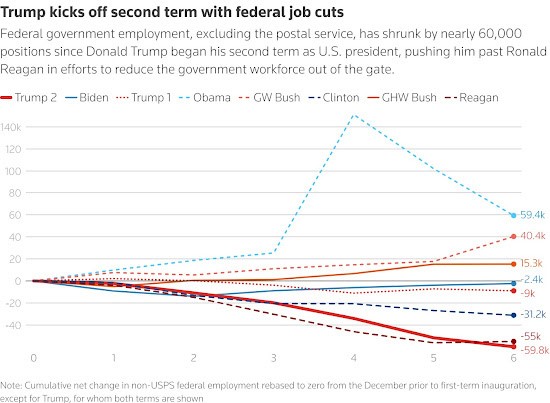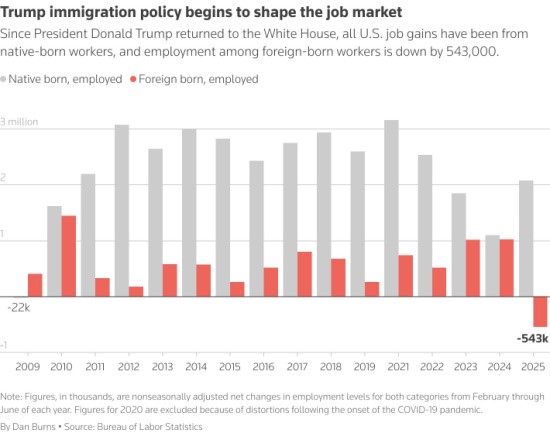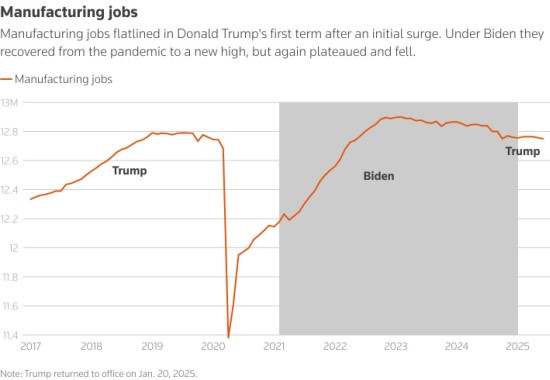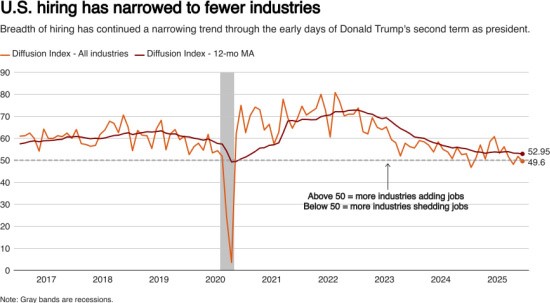Roughly half a year into his second stint in the White House, President Donald Trump is starting to shape portions of the U.S. job market through his policy changes, including aggressive crackdowns on immigration and reductions in the federal workforce.
Less evident so far, though, is any indication of a rebound in factory employment, one of the chief goals of his imposition of sweeping tariffs on goods from foreign trading partners. Also the breadth of hiring continues on balance to narrow, reflecting ongoing uncertainty among businesses about the outlook under the shifting Trump policy landscape.
Since Trump took office, the U.S. labor market has continued to thrive. On Thursday, the Labor Department reported that U.S. employers added 147,000 jobs in June, far more than the expected 110,000, as the American labor market continues to show surprising resilience despite uncertainty over President Trump’s economic policies.
Furthermore, the unemployment rate ticked down 4.1% from 4.2% in May.
This is the fourth straight beat on payroll gains compared with economists’ forecasts. Trump's economy continues to prove better than the expected consensus — particularly on solid job growth and tame inflation.
Here's a look at how some of the employment data is shaping up in the face of Trump's policies.
FEDERAL WORKERS
The U.S. government workforce — excluding the U.S. postal service — shrank again in June, and Trump has now overseen more net reductions in the federal workforce in his early months than any president since Dwight D. Eisenhower.
.jpg.aspx;)
The decline of 8,100 federal positions last month pushed his running total to almost 60,000, edging him past fellow Republican Ronald Reagan, who had overseen a reduction of 55,000 in the first months of his presidency in 1981.
That trajectory is likely to increase in late summer when the tens of thousands of federal workers who accepted a deferred resignation offer from the Trump administration will formally leave federal employment.
IMMIGRATION

Trump has launched raids to round up undocumented migrants, starting with criminal illegal aliens; rescinded the legal status of thousands of other immigrants; and in general has slowed the inflow of foreigners allowed to work in the U.S.
That has reversed the trend under his predecessor, Democrat Joe Biden, that had seen foreign-born workers contribute roughly as much or more to overall employment and labor force growth than those born in the U.S., due to Biden's open border policy.
From February — the first full month of Trump's second term — through June, all employment growth has come from native-born workers. Employment among those born here rose by 2.1 million in that period, while employment among foreign-born workers dropped by more than half a million.
That's the largest February-through-June slide in foreign-born employment since at least the first year of Democrat Barack Obama's presidency.
FACTORY WORK
A key policy goal of Trump's tariffs has been to boost U.S. manufacturing employment, which has been in a long-term downtrend as companies offshored goods production to places like China and Mexico.
It had seen a modest recovery in Trump's first term and again after the COVID-19 pandemic, but that recovery stalled more than two years ago and there were 5,000 fewer factory jobs in June than in January.

The number of manufacturing jobs in June fell by 7,000 to its lowest overall since October. Factory employment as of last month was around the lowest in three years.
BREADTH OF HIRING
While 147,000 new payroll jobs were created last month, the gains were led by an increasingly narrow set of employment sectors. State government jobs, in education largely, led the way, followed by the healthcare sector. Private payrolls overall experienced their smallest increase since October, in keeping with surveys of businesses that show great uncertainty about the evolving outlook from Trump's tariff policies in particular.

The Bureau of Labor Statistics' diffusion index, which tracks the breadth of hiring across 250 industries, fell back below 50 for the second time in three months. That indicates slightly more industries were reducing employment than adding to it and continues a narrowing trend.
The average breadth of hiring over the last 12 months is the narrowest since August 2020 and is the lowest of any Trump presidency month — excluding the early days of the pandemic — going back through his first term.
© 2025 Thomson/Reuters. All rights reserved.